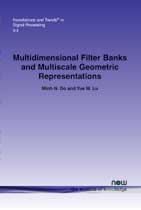Multidimensional Filter Banks and Multiscale Geometric Representations
By Minh N. Do, Department of Electrical and Computer Engineering, University of Illinois, USA, minhdo@illinois.edu | Yue M. Lu, School of Engineering and Applied Sciences, Harvard University, USA, yuelu@seas.harvard.edu
Abstract
Thanks to the explosive growth of sensing devices and capabilities, multidimensional (MD) signals — such as images, videos, multispectral images, light fields, and biomedical data volumes — have become ubiquitous. Multidimensional filter banks and the associated constructions provide a unified framework and an efficient computational tool in the formation, representation, and processing of these multidimensional data sets. In this survey we aim to provide a systematic development of the theory and constructions of multidimensional filter banks. We thoroughly review several tools that have been shown to be particularly effective in the design and analysis of multidimensional filter banks, including sampling lattices, multidimensional bases and frames, polyphase representations, Gröbner bases, mapping methods, frequency domain constructions, ladder structures and lifting schemes. We then focus on the construction of filter banks and signal representations that can capture directional and geometric features, which are unique and key properties of many multidimensional signals. Next, we study the connection between iterated multidimensional filter banks in the discrete domain and the associated multiscale signal representations in the continuous domain through a directional multiresolution analysis framework. Finally, we show several examples to demonstrate the power of multidimensional filter banks and geometric signal representations in applications.
Multidimensional Filter Banks and Multiscale Geometric Representations
Thanks to the explosive growth of sensing devices and capabilities, multidimensional (MD) signals-such as images, videos, multispectral images, light fields, and biomedical data volumes-have become ubiquitous. Multidimensional filter banks and the associated constructions provide a unified framework and an efficient computational tool in the formation, representation, and processing of these multidimensional data sets. Multidimensional Filter Banks and Multiscale Geometric Representations provides a systematic development of the theory and constructions of multidimensional filter banks. It thoroughly reviews several tools that have been shown to be particularly effective in the design and analysis of multidimensional filter banks, including sampling lattices, multidimensional bases and frames, polyphase representations, Gröbner bases, mapping methods, frequency domain constructions, ladder structures and lifting schemes. It then focuses on the construction of filter banks and signal representations that can capture directional and geometric features, which are unique and key properties of many multidimensional signals. Next, it studies the connection between iterated multidimensional filter banks in the discrete domain and the associated multiscale signal representations in the continuous domain through a directional multiresolution analysis framework. Finally, it shows several examples to demonstrate the power of multidimensional filter banks and geometric signal representations in applications. Starting from basic concepts such as multidimensional filtering and nonseparable sampling, Multidimensional Filter Banks and Multiscale Geometric Representations presents a systematic overview of the common notation, key tools, and main results in the characterization and design of multidimensional filter banks. In doing so, this book can serve as a starting point and helpful guide for those readers who would like to further explore this exciting topic.
